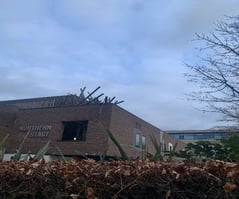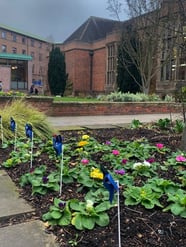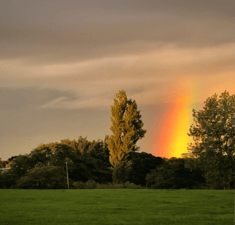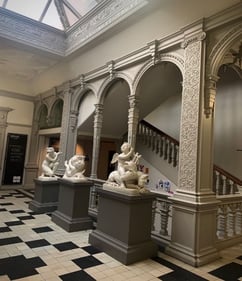Behind the lens...
Published: 9 February 2024 | Updated: 9 February 2024 | By: Newcastle University | 3 min read.png)
The Behind the Lens project explores the queer spaces identified and created by the students and staff of Newcastle University.
Post-grad student, Jay, met with the organisers of the project to find out more.
Organised by Dr. Tina Sikka and Dr. Katie Markham, co-directors of Equity, Diversity, Inclusion (EDI) in the School of Arts and Cultures (SACS), the Behind the Lens project explores the queer spaces identified and created by the students and staff of Newcastle University. Queer spaces are defined as “key environments through which queer folks have found safety, community and belonging” (Pavka, Evan. What Do We Mean By Queer Space?). Through the contributions of anonymous student participants, the project highlights the importance of such spaces throughout our campus.
Although the images collected throughout this project might be recognisable to all students, Behind the Lens places importance on the meanings that students have attributed to them. Marginalised groups rely on safe spaces and, in the lead-up to LGBT+ History month, it is important to hear from LGBTQ+ members of the Newcastle University community. As stated by Dr. Sikka and Dr. Markham, the goal of this project is to “create room and recognition for marginalised communities”. By showcasing the findings of the Behind the Lens project in this blog post, we hope students will consider the spaces on campus that they themselves value, and think further about how we can all contribute to creating a safe, equitable and supportive environment.
Click the images to enlarge.
Photo 1: “The newly planted flowers on campus reminds me that spring is on its way! I love the colours and brightness they add to the campus buildings and reminds me of the LGBTQ+ flag.”
Photo 2: “I took this picture when walking into campus. On this day there was a rainbow that appeared in the distance over campus. It reminded me of how welcoming and kind everyone I have met on campus is to me. I also associate town moor and campus with socialising, and this is important to my friendship group.”
The first two images showcase some of the natural beauty surrounding our campus. The participant who submitted photo 1 finds similarities between the colours of spring and the LGBTQ+ pride flag. Drawing on this comparison, Dr. Sikka and Dr. Markham hope that we can recognise the uniqueness and beauty inherent in ourselves, just as easily as we recognise it in the natural world around us.
Photo 2 is a stunning snapshot of a rainbow above Town Moor, taken by the participant as they walked to university. Beyond the more obvious associations of rainbows and the LGBTQ+ community, the participant highlights how the image reminds them of the welcoming community within our university.
Photo 3: “My favourite part of campus is going to The Grand with my friends in between lectures. I have realised how close and supportive my friendships in University are especially when concerning motivation and support in my education. Little trips to coffee shops like this on a snowy winters day make all the difference.”
This participant highlights on-campus coffee shop, The Grand, as a queer space. Importantly, this expands the concept of a queer space beyond those explicitly designed as such. By creating a welcoming and inclusive environment, any space has the potential to be a queer space.
 Photo 4: “I recently visited the Northern Stage theatre to watch a performance of Kin which presented community and migration through expressive dance. I really enjoyed this and it reminded me how supportive and friendly my own community in Newcastle is.”
Photo 4: “I recently visited the Northern Stage theatre to watch a performance of Kin which presented community and migration through expressive dance. I really enjoyed this and it reminded me how supportive and friendly my own community in Newcastle is.”
Photo 5: “I always come to the Hatton art gallery for a quiet and relaxing place to spend time on campus.”
Northern Stage and the Hatton Gallery are hubs of art and culture in the heart of campus. Behind the Lens emphasises how “students can easily find their own forms of joy through differing forms of self-expression and art on campus”.
Photo 6: “Especially in final year with me undertaking my dissertation, the Philip Robinson is a place I find a lot of joy in on campus, as it is a place for me and my friends to help each other grow and learn in our degrees. I learnt that despite our differences we can all come together and help each other succeed at University. And chilling with some coffees in between sessions is a plus!!!”
Photo 6 is one of the many photos received of Newcastle University’s libraries. This participant recognises that libraries serve a purpose beyond cramming for exams – when working alongside others, libraries become sites of community. Dr. Sikka and Dr. Markham encompass this perfectly.
“At Newcastle University, libraries are not just a place for students to study on their own, but also a place where they can meet other students and learn from each other. With a wide range of spaces, books and facilities which can cater for the needs of all and every student, Newcastle University libraries always successfully promote a true diverse and inclusive environment. Despite student’s differences, they can share knowledge, skills and can grow together.”
Queer Spaces: why are they so important? Jay's reflections:
As a queer student myself, I see my experiences mirrored in the participants’ contributions to Behind the Lens. A queer space isn’t just a gay bar – rather, it is anywhere that I feel valued and safe to be myself. By emphasising the queer spaces that exist across campus, Behind the Lens shows that the meanings we attach to spaces are just as important as the spaces themselves. To create these safe spaces, all students – regardless of identity – can come together and promote an inclusive environment.
Through their contributions, students have been able to express their thoughts and feelings towards the EDI practices on campus. Dr. Sikka and Dr. Markham emphasise the importance of recognising these spaces – by showing they exist, they hope to demonstrate Newcastle University’s commitment to creating an inclusive environment for all.
Resources
Finally, as part of the Behind the Lens project, a list of resources has been compiled. Here, these are divided into resources showcasing local LGBTQ+ organisations and individuals, and resources for further information about queer spaces.
LGBTQ+ Organisations and Individuals
Canny Queer Collective is ran by Newcastle University students and graduates and hosts a range of events in Newcastle.
BE: is a charity founded by trans people, for trans people. They provide weekly support meetings every Tuesday, 6pm – 8pm, at the ReCoCo building.
Olive’s Book Club is a queer. Independent, online bookshop.
Lady Kitt is a disabled artist and drag king. They are heavily involved in Newcastle’s creative scene and recognised for their socially engaged art.
Further Information
‘Queer Spaces in Architecture and Culture’ by Pratt Futures. This discussion provides more information about queer spaces in contemporary culture and architecture.
‘Inclusive Spaces: Trans Visibility and the City’ by The Bartlett, UCL Faculty of the Built Environment. As part of a monthly series by UCL, this episode discusses how sexuality interacts with the built environment.
Bibliography on Gender, Sexuality and Space. A collection of further reading on the topic.
‘Azure: What Do We Mean By Queer Space?’ by Evan Pavka.




